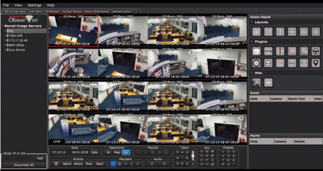One of the most exciting developments in internet technology is the increasing fluency with which various devices can communicate with each other over the web, providing users with a harmonised digital experience, writes Pauline Norstrom, MD of NetVu, the video surveillance manufacturer.
Via a few screen taps or voice commands, smartphones, laptops, lights, speakers, TVs, even combi-boilers are unified in a way that automates, streamlines and speeds up formerly manual processes in the most delightful ways. This web-based unification of internet-ready hardware has come to be known as ‘the Internet of Things’ and an ever more present component within these ‘things’, is CCTV.
How the IoT is transforming the CCTV industry
Organisations of all types and sizes are starting to introduce IoT technology alongside Cloud services to enhance the efficiency of their existing CCTV hardware. There was a notable spike in activity in the months leading up to the enactment of the General Data Protection Regulation (GDPR) given the extra securities that organisations had to achieve. For example, IoT-enabled CCTV equipment allows for visual data to be captured and stored securely off-site for as long as required and viewed remotely by authorised personnel using their smartphone, tablet or PC. Rather than waiting potentially weeks for law enforcement to pick up flash-drives of incriminating footage, the evidence can be emailed directly to them and used straight away.
A further advantage lies in the fact that criminals often damage or destroy CCTV equipment at some point during the committing of a crime. IP CCTV ensures that evidence recorded prior to the destruction of the hardware is both secure and out of reach of the perpetrators.
Maintaining integrity
Various devices communicating with each other over the cloud presents obvious risks to security which, if left unchecked, are easily capitalised on by hackers and rogue software. Where IP CCTV is concerned, these new cybersecurity challenges threaten the very technology deployed to protect their organisations. There is mounting pressure on the surveillance industry to establish a quick and firm grip on keeping hackers out of surveillance devices connected through the IoT. This can be achieved by devising more secure firewalls and more comprehensive monitoring which alerts security leaders to the presence of potential hackers.
Also needed are better inventories of the devices connected to IP networks. For many organisations, security equipment alone can include hundreds, even thousands of devices responsible for such diverse tasks as access control, intrusion detection, video surveillance, and an array of sensors.
Getting it right from the start
The role of CCTV has morphed in recent years to become something much more than footage extraction from glorified, wall-mounted camcorders. Contemporary devices are connected to the web, can react to movement, achieve 360° visibility, produce night-vision images, record in HD, accurately detect heat, smoke and flame, and instantly alert appointed parties when a breach is detected. They digitally store masses of data and provide significant ROI with the manual and man-powered tasks they eliminate.
For this degree of capability, for the information they record and hold, and for their impact on the security and prosperity of organisations, it is unacceptable for the infrastructures that support IP CCTV to be vulnerable to attack. Yet they are. Attempts to remedy the vulnerabilities associated with IP CCTV have largely centred around creating systems which are completely separate from the organisation’s network, thereby rendering them useless as a ‘host’ for attacks. Though sometimes successful, this approach does not represent a forward move for the industry.
Closed IPTV
To programme IP cameras individually and design firewalls and VLANS that ensure complete protection of a corporate network, installation times are multiplied many times over. It’s an additional cost which can be painful and much more so when problems arise.
Clear that the progressive solution was to instead integrate IP CCTV systems into business operations, NetVu began devising a next-generation solution fit for the modern world. It was a move as much designed to deliver on assurances of ROI as well as a bolstering of security. The fully patented solution was released to the market as Closed IPTV. The system is integrated into all NetVu Connected devices and employs innovative design with standard IT industry protocols including automatic port mapping to camera, zeroconf IP address allocation, dual IP addressing, automatic creation of firewalls, and secure VLANS for the IP cameras themselves. For end-users, the critical benefit comes from having an IP CCTV system fully protected from malicious threats whilst access to it is from the corporate network is maintained without the fear of risking further vulnerabilities.
Your IP CCTV equipment protects your business from harm, protecting it from harm provides that extra layer of defence to your premises, your people, and your profits.









